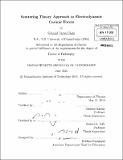Scattering theory approach to electrodynamic Casimir forces
Author(s)
Rahi, Sahand Jamal
DownloadFull printable version (10.45Mb)
Alternative title
Scattering theory approach to electrodynamic Casimir interactions
Other Contributors
Massachusetts Institute of Technology. Dept. of Physics.
Advisor
Mehran Kardar and Robert L. Jaffe.
Terms of use
Metadata
Show full item recordAbstract
We give a comprehensive presentation of methods for calculating the Casimir force to arbitrary accuracy, for any number of objects, arbitrary shapes, susceptibility functions, and separations. The technique is applicable to objects immersed in media other than vacuum, nonzero temperatures, and spatial arrangements in which one object is enclosed in another. Our method combines each object's classical electromagnetic scattering amplitude with universal translation matrices, which convert between the bases used to calculate scattering for each object, but are otherwise independent of the details of the individual objects. The method is illustrated by rederiving the Lifshitz formula for infinite half spaces, by demonstrating the Casimir-Polder to van der Waals cross-over, and by computing the Casimir interaction energy of two infinite, parallel, perfect metal cylinders either inside or outside one another. Furthermore, it is used to obtain recent results: the Casimir energies of i) a sphere or ii) a cylinder opposite a plate, all with finite permittivity and permeability, to leading order at large separation, iii) a parabolic cylinder opposite a plate, both representing perfect metal boundaries, and iv) a sphere or spheroid inside a cavity, where both the inside object and the cavity walls have realistic material properties. We also examine whether electrodynamic Casimir forces can lead to stable levitation. Neglecting permeabilities, we find that any equilibrium position of objects subject to such forces is unstable if the permittivities of all objects are higher or lower than that of the enveloping medium; the former being the generic case for ordinary materials in vacuum.
Description
Thesis (Ph. D.)--Massachusetts Institute of Technology, Dept. of Physics, 2010. Cataloged from PDF version of thesis. Includes bibliographical references (p. 117-123).
Date issued
2010Department
Massachusetts Institute of Technology. Department of PhysicsPublisher
Massachusetts Institute of Technology
Keywords
Physics.